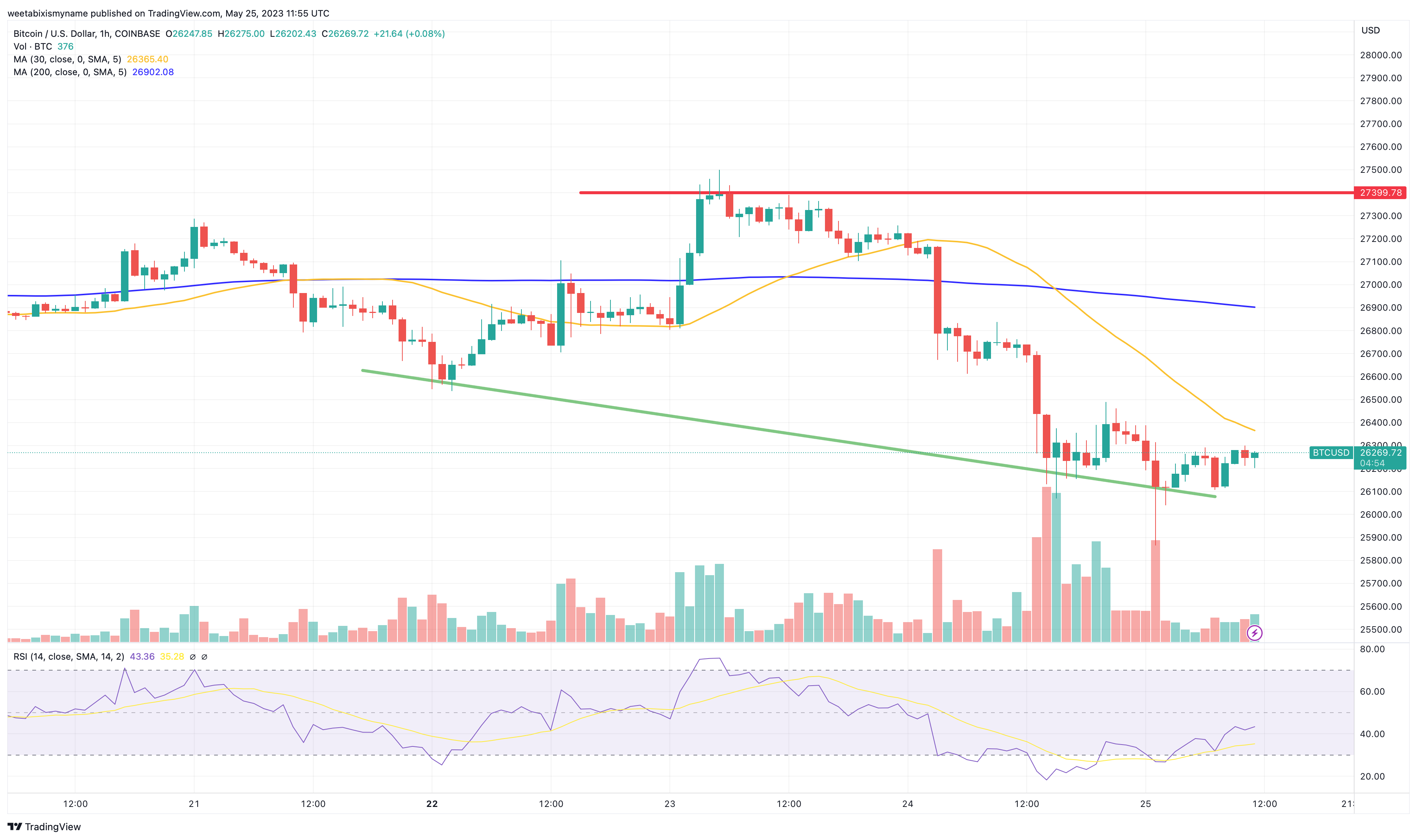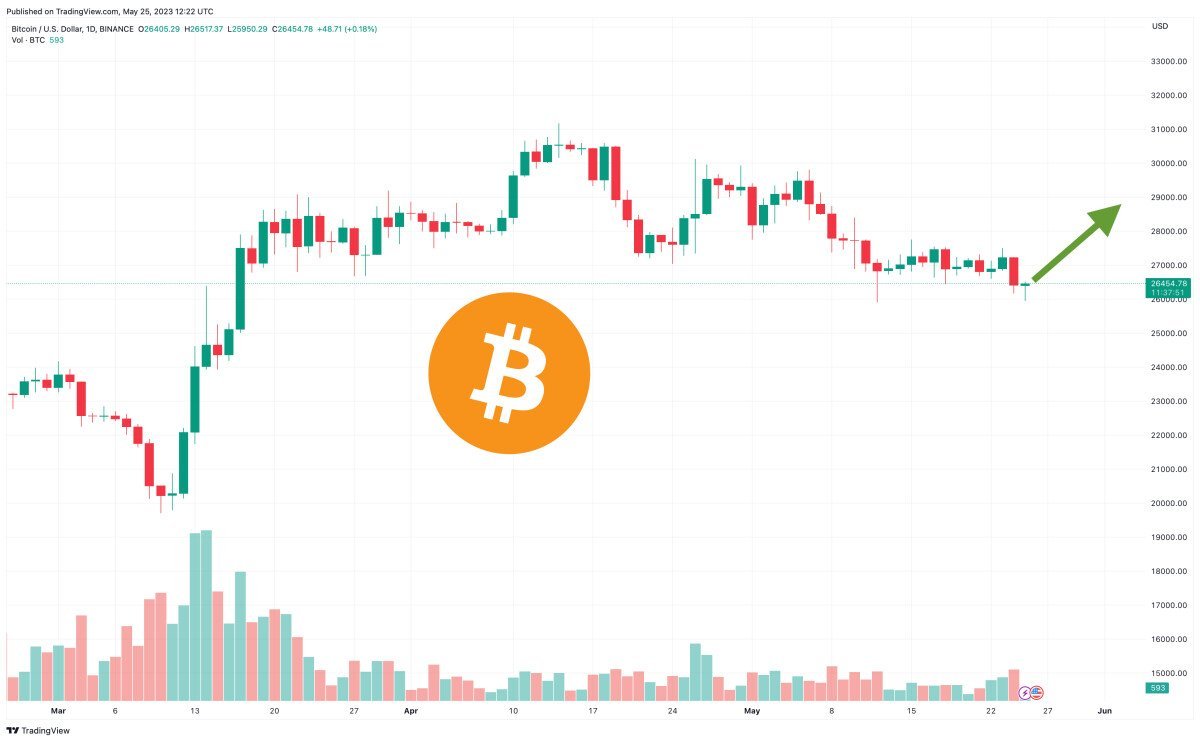Future of Bitcoin: The price of Bitcoin has experienced a 1.5% drop today, reaching $26,244, as the cryptocurrency market faces uncertainty due to the potential US debt default. Over the past week and month, Bitcoin has seen losses of 4%, although it is still up by 58% since the beginning of the year.
Despite the recent price dip, data indicates that Bitcoin’s mining difficulty has reached an all-time high. This suggests that more miners are looking to accumulate Bitcoin during the ongoing bear market. Additionally, there has been an all-time high in the amount of Bitcoin that has remained unmoved for at least 10 years, indicating that serious market participants are patiently holding their positions, awaiting the next bull market.

While Bitcoin experienced a fall overnight, there are signs of a slight recovery this morning, with indicators showing regained momentum. The relative strength index (RSI) has moved above 40, indicating incoming buying pressure after reaching an oversold position of 20. Although the 30-day moving average is still declining, it is not as steep as it was previously, potentially suggesting improved performance in the coming days.
One positive development is that the support level around $26,100 has held up, with Bitcoin refusing to drop further. However, given the concerns surrounding the US debt default, it remains uncertain whether this support level will be maintained or if Bitcoin will experience further declines.
On a positive note, Bitcoin’s fundamentals remain strong. The record-high mining difficulty demonstrates the robustness of its network, and the increasing hashrate reflects the amount of computing power securing the cryptocurrency’s network. Unlike certain altcoins, Bitcoin has never suffered a network outage, solidifying its reputation as a safe cryptocurrency for investment.
Amidst the current market conditions, it appears that many investors, including whales and miners, are in an accumulation phase, anticipating the next significant rally. Miners have started hoarding Bitcoin instead of selling it, and the balance of BTC on exchanges has reached a one-month low. Additionally, there is an all-time high of Bitcoin that hasn’t moved for at least ten years, along with a rise in the number of wallet addresses holding at least 1 BTC.
While the focus on the US debt ceiling crisis remains negative, there have been positive updates regarding national economies. For example, the IMF predicts that the UK will avoid a recession this year, and the Eurozone managed to evade a recession in the first quarter. These modest improvements may take time to translate into significant gains for Bitcoin and other cryptocurrencies, but the overall trend seems to be improving.
The resolution of the US debt ceiling crisis could initiate a gradual recovery for Bitcoin throughout the rest of the year, potentially pushing the price back up to $27,000 and $28,000. Looking further ahead, the next Bitcoin halving, expected in April or May 2024, could inject bullish momentum into the market, leading to a potential significant rally in the weeks leading up to the event.
While Bitcoin may require major adoption and investment news from significant players to reach new record highs, its accumulation by core investors and the market provides a solid foundation for another substantial rally in the foreseeable future.
It’s important to note that the recovery of Bitcoin and the cryptocurrency market as a whole depends on the resolution of the US debt ceiling crisis. However, considering that the US has successfully resolved similar crises in the past, there is optimism that a positive outcome will be reached for the current situation as well.
Assuming the debt ceiling issue is resolved, Bitcoin could gradually recover throughout the remainder of the year. It may reclaim levels around $27,000 and $28,000 and potentially experience further growth in the subsequent months.
Looking even further into the future, the next Bitcoin halving, anticipated to occur in April or May 2024, could act as a catalyst for a significant bull run. Historical patterns have shown that Bitcoin often rallies in the weeks leading up to a halving event. Therefore, market participants might anticipate and position themselves ahead of this event, potentially driving the price of Bitcoin upward.
While it’s possible that Bitcoin might require major adoption and investment news from significant players to reach new all-time highs, the ongoing accumulation of the cryptocurrency by core investors and the market suggests a strong foundation for future growth. The hoarding behavior of miners and the decrease in BTC balance on exchanges indicate a strategic approach by industry participants, further supporting the notion of a potential rally in the not-too-distant future.
It’s important to keep in mind that the cryptocurrency market is inherently volatile, and price predictions should be approached with caution. Various factors, including global economic conditions, regulatory developments, and technological advancements, can significantly influence the price of Bitcoin and the overall cryptocurrency landscape.
In conclusion, while the current market conditions are uncertain due to the US debt default concerns, there are positive indicators for the future of Bitcoin. Its strong fundamentals, growing mining difficulty, and accumulation by key players suggest that the cryptocurrency has the potential for gradual recovery and even a significant rally in the coming months and years.

